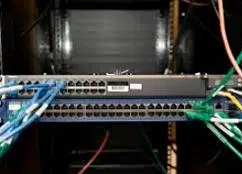 Commutator is an adjective that is used to describe that which commutes : replaces, modifies, replaces or changes something. As a noun, the idea of a switch can refer to different devices.
Commutator is an adjective that is used to describe that which commutes : replaces, modifies, replaces or changes something. As a noun, the idea of a switch can refer to different devices.
A commutator can be a device that allows an electric current to change conductor . To achieve this objective, the switch causes the electrons to follow a different path.
The operation of these switches is similar to that of switches . While switches are responsible for disconnecting an electrical circuit, commutators cause current to pass to another conductor to connect a different circuit.
In the field of telephony , the machine that is responsible for connecting different telephone lines is called a switch. Also known as a switchboard , the switch allows two points to be linked through different nodes. In other words, the switch determines the path that establishes communication between two users, said path remaining “busy” until the communication in question ends.
Switching in the context of a telephone network is not a simple action, but is made up of different stages , and all of them must be successful for communication to take place. First is the connection request , which must be approved to proceed to call establishment ; Next, the stage begins in which data transfer occurs between the different nodes; finally, connection release must be executed.
Let's look at some of the advantages of using a switch for telephone communication:
* The transmission takes place in real time , something essential for this type of communication. Currently, it is possible to establish a connection that transmits audio and video data in real time, something that we can see in the so-called video calls ;
* throughout each session, the nodes participating in the communication have exclusive access to the resources, and this guarantees an acceptable level of quality;
* there is no containment . This means that since the circuit is established, the nodes can transmit data at the maximum speed allowed by the medium, and must not share the time of use or the bandwidth;
* Once the circuit is established, it is not necessary to spend time performing calculations and routing those nodes that are among the main ones, since the switch allocates a specific physical circuit to each communication session. In this way, intermediate nodes receive a single route for packets, both incoming and outgoing.
Of course, the switch also has certain disadvantages, such as the following:
 * the start of communication is not immediate, since it is necessary to dedicate time to the first stages, so that it is not possible to transmit the data until these have been completed;
* the start of communication is not immediate, since it is necessary to dedicate time to the first stages, so that it is not possible to transmit the data until these have been completed;
* while the parties are not using the resources assigned to them, they are wasted;
* the communication path is fixed and this prevents it from being readjusted according to the needs of each connection;
* If an intermediate node fails, the entire circuit goes down and it is necessary to start the process again.
For computing , a switch is a logical digital element that serves to interconnect different sections of the network. The switches carry data from one segment to another according to the destination MAC address of the different frames existing on the network.
Thanks to a switch of this type, various sections of a network can be connected so that they are merged. Because they only transmit data to the segments in which there is a recipient, they improve the security and performance of the so-called local area networks.
